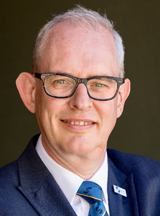
Prof. Bart Morlion, MD, PhD,
Prof. Bart Morlion, MD, PhD, is president of the European Pain Federation EFIC. Although trained as an anesthesiologist, for the past 2 decades he has focused 100% in pain medicine. Prof. Morlion is the director of the Leuven Centre for Algology & Pain Management at the University Hospitals of Leuven. He teaches pain management and pharmacology at the University of Leuven Medical School where he directs a multidisciplinary pain center.
His professional interests include all aspects of multimodal chronic pain management, cancer pain management, pharmacotherapy of pain and quality management.
This article is part of an ongoing series to raise awareness of a broad set of topics impacting orthopaedic practice to broaden the collaborative discussion around improving patient surgical outcomes, especially postoperative pain management (POPM), and to develop solutions that improve practices across Europe. The opinions expressed in this interview are meant as an informal conversation to facilitate dialogue.
To further discuss the opinions expressed in this article, engage on Twitter, Facebook and LinkedIn at #painmanagement, #changepain and #POPM. The article was initially published in Orthopaedics Today Europe, April 2019
We talked with Prof. Bart Morlion about his views on effective pain treatment in the eyes of ever-shortened hospital stays and the collaboration required in cross-functional teams to fill those gaps. A summary of our conversation follows.
Nowadays, it seems that as surgical techniques improve and technologies advance, more patients are leaving the hospital setting with shorter lengths of stay, with many even going home the same day. What impact does this have on the treatment of postoperative pain and what should practitioners keep in mind?
Indeed, nowadays many patients will be managed in same-day discharge settings. In well-selected, mostly relatively healthy patients, even hip and knee arthroplasties are offered in day case surgery. That is a completely different situation from 10 to 15 years ago when each of these patients stayed for several weeks in the hospital. Today, if there are older patients, for example, then there often needs to be a first 1 or 2 nights in the hospital, so there is still not a pressure for the same-day discharge of all patients.
To be clear, most patients – whether leaving the hospital setting same-day or longer – will have pain afterward. Early mobilisation is important so in many cases, this involves chasing the patients following the surgery to keep up their exercises with the physical therapist. Early mobilisation, however, is only as good as the pain management plan that accompanies it. We know if a patient suffers from acute pain immediately after a joint replacement, that is also directly correlated to the risk of developing chronic pain, so there are many reasons to need to find the proper balance between quick mobilisation and early discharge and having a strong coordination with exercise or a rehabilitation program while simultaneously giving patients the opportunity to have access to pain relief.
One of the key issues for practitioners to keep in mind with the pain management plan is the aim to reduce the opioid load. This can be achieved with the use of multimodal analgesia consisting of the combination of nonopioids (eg, paracetamol and NSAIDs) and atypical analgesics (eg, pregabalin, ketamine). Following surgery, the changing nociceptive system might require an initial use of opioids that should then be tapered off with multimodal pain strategies that do not rely on one, single pharmacological agent. While each patient is different, it is rare that a pain plan can avoid 100% the use of opioids as a strong analgesic in the first hours and days following a surgery. In these cases, transitioning a patient from hospital care to home puts the burden and trust of pain management more into the hands of patients. For this, they need to have access to opioids, but also should be educated on opioid-sparing techniques. In this way, the patient can avoid being left to herself or himself taking strong opioids over many weeks.
You put a lot of emphasis on the pain management plan to guide the patients and their treatment on specialists in the days and weeks following discharge. Would you recommend a template to follow with best practices for such a plan?
You pose this question to the wrong person because I fundamentally do not believe in cookbook recipes in pain management. Attention to the individual and their detailed case is extremely important. Nevertheless, practitioners in a multidisciplinary team need some guidance and standing orders because uniformisation of the pain management strategy goes toward the overall quality of the patient’s pain outcomes. With that in mind, there are a few aspects to take into consideration.
It starts with having a good evaluation of the patient and the patient’s pain situation or indications prior to the surgery. There is a huge difference in those patients who for many months and years have already been experiencing pain, which is often the case with knee and hip surgical replacements, and those patients who have historically had lower levels of pain but are undergoing a surgery post-trauma. A lot of patients with osteoarthritis, for instance, already have sensitised systems, so perhaps the strategic approach to pain management requires a more aggressive long-term strategy to eliminate pain, as opposed to the patient who has a sudden fracture due to a fall or traffic accident where the pain is more neuropathic in its causation.
Intraoperatively, there are shifts in techniques looking toward interactively managing pain. Many anesthesiologists work with regional anesthesia, while others go for nerve blocks. What is an interesting development to continue to be looked into for its effects on long-term pain, is that orthopaedic surgeons can offer during hip or knee replacement a positive strategy themselves by providing broad analgesic infiltration of the wound. This process seems to work as well as more sophisticated blocks that are performed by the anesthesiologist.
This is a new development, and it is interesting with regard to how such a multidisciplinary approach can support multimodal approaches afterward, such as the combination of nonopioid analgesic drugs with certain types of NSAIDs, combined with opioids but looking more at syringe-based medications, like ketamine, to reduce opioid dependency. These are approaches that were formerly considered exotic but nowadays allow for a much more adaptive coverage in the immediate perioperative period.
By focusing on the preoperative and perioperative pain strategies, the pain management team can be adaptive to the patient’s unique pain profile and risks for pain chronification. It is important, therefore, to focus on reducing the opioid burden so that when the patient goes home, he or she has access to strong painkillers but with a clear message that with ongoing rehabilitation pain should wear off.
As a standard, who should be responsible to ensure that these pain management strategies are put into place? Does it require a broad consensus or coordination, or is there one specialist who should lead?
Once again, it should be noted that I am against the idea that it should be any singular standard for all patients because I am a believer in interdisciplinary care, but interdisciplinary care asks a lot of efforts of many people, which also becomes extremely costly once you start involving two or three specialists in the care. Still, somebody should feel responsible to check on these patients once they have left the hospital setting, and that is one of the problems because across Europe the modality for how these checks are performed is completely differently organised.
In some countries, there is effective follow-up via a call system by specialised nurses who make contact directly with the patient or systems where a patient comes into a rehabilitation center and can get not only help, but some medical advice on overall pain management. In other countries, patients are sent home on paracetamol, which is clearly not always enough to do the job. There is a huge inequity in Europe, and this is a clear point of discussion amongst colleagues over the past few years.
In the practices where I have participated, we have a more pragmatic view: That there is a specific orthopaedic service assigned to key postoperative pain and rehabilitative cases, especially those at risk for chronic pain. The ideal would be to have at least an orthopaedic surgeon with a special interest in pain who would be more the intermediary or the gatekeeper to be called in for more specialised care cases. This is a bit of the middle-ground approach and a more workable strategy but in all cases, the minimum should be to have a pain specialist involved and ready to take the lead because there is a prevalence of persistence in postoperative pain or in chronification of pain so high that we need stepped-up approaches to have more engaged people in different specialties focused on pain management.
It is the duty of every specialist to manage pain. If you inflict pain, then it is part of your job to treat pain. This is the reason why in our pain organisation we are so open to other specialties, because it is not only the job of a so-called “pain specialist.”
You mention the inequities in pain management across Europe. In your observations, to what would you attribute these variations?
In some countries the use of opioids is still extremely limited, especially in the Eastern European region going from the Baltics down through Ukraine. In other countries, there are still limitations even on the possibility of use of opioids, especially for patients leaving the hospital and having their own access to the medications. At the same time, at the other end of the spectrum, there are patients put on fentanyl patches with no instructions to taper down and then suddenly 6 months after discharge, a patient with a knee surgery half a year prior is still on high doses of opioids. This is what I mean when I say there needs to be some sort of standardisation for good practice to build an effective schedule, allowing access to strong pain relievers in the beginning, but having someone responsible for follow-up to ensure the tapering down of this therapy.
It is not an easy answer as to how to resolve this imbalance in practices in different countries. In many ways, it is attributed to the political approach toward health care in general or the specific instances in each country. This is why it is important that notwithstanding geographies, specialists should work together to put in place the best strategies and solutions for better long-term patient outcomes.
You state that somebody should be assigned to follow-up. Is there a best practice on who this is?
To again be clear, most patients will have pain and will have follow-up in the sense that they will be performing their exercises with their physical therapist. That itself is a touchpoint that allows instruction and education on how to alleviate pain. In the ideal world, though, it would be the orthopaedic surgeon for the surgical procedure to proactively follow up. This, unfortunately, is not always the case. In the 3 days following the surgery, in most countries an anesthesiologist will follow up and then the follow-up in large part drops to zero following the fourth day. At that point, anesthesiologists no longer feel responsible for pain management. There are exceptions, though this is what is observed in most countries. Ideally, I repeat, there should be a well-organised orthopaedic service that has a clear, uniform methodology of follow-up.
With some patients, this is possible to do digitally, for example, with lesser application of heavy resources. All of these things are possible, but not thoroughly applied. What is a strong practice and what is generally observed as appreciated by patients are calls by specialist nurses. For large groups of patients, this is not always feasible to offer, but for those in specific select groups of patients observed to be at risk for pain issues, we make contact at 6 days after surgery with our patients.
In most European countries, the nurses cannot, for example, prescribe new medications, but they have specific skills to advise and remind patients on how to properly use their pain relievers and especially when to contact, for instance, their general practitioner. This is something that is workable and is not too costly to implement while overall improving pain management during the transition from the hospital to the home.
One other important point is that there should be a warning system in place when follow-up determines that a patient is at risk of developing chronic persistent pain. We have noticed, for instance, that with knee surgery one in five patients will develop a continuing persistent pain. These and other high-risk patients are flagged for follow-up with a pain specialist.
Overall, best practices would indicate that it should be the orthopaedic surgeon who takes the lead on filling that postoperative pain management gap following discharge, but more of this role is being played instead by the physiotherapist?
Yes. I repeat: If you inflict pain, then it is part of your job to treat pain.
With 20 years dedicated to fighting pain and seeing changes in pain practices, what is the area you are most proud of as change takes place across Europe?
It is not a personal achievement of my own, but a collaborative achievement across practices, in general. I have found it promising with the people I have met, for example, in organisations like EFORT, who are open to talk and open to networking looking for the best strategies to the benefit of their patients. In all sorts of fora across the continent, we are meeting with people who are building dialogues and forming collaborations across disciplines that will help us determine the directions we should go in pain management.
When I was very junior, I once did a study on postoperative pain management, which showed that offering patients after an operation only the feeling that you care was enough to measurably reduce pain. In such cases, we found you could start reducing doses of controlled analgesia to even very low doses and patients were still satisfied. This gave them the feeling of control over their pain and that someone was carrying the burden for them and asking them about it already helped a lot.
From the point of view of the European Pain Federation, we are pleased with discussions like these and find all federations working toward reducing pain and identifying paths forward to be promising.
Further reading:
- Kress HG, et al. Curr Med Res Opin. 2015; doi:10.1185/03007995.2015.1072088.
- Meissner W, et al. Curr Med Res Opin. 2015; doi:10.1185/03007995.2015.1092122.
- Morlion B, et al. Curr Med Res Opin. 2018; doi:10.1080/03007995.2018.
- O’Brien T, et al. Eur J Pain. 2017; doi:10.1002/ejp.970.
For more information:
As the platform organisation linking Europe’s national orthopaedic associations, the European Federation of National Associations of Orthopaedics and Traumatology (EFORT) partners with Grünenthal to raise further awareness of the unmet needs in POPM and to develop solutions that improve POPM across Europe.
For 6 months, we will involve experts from across Europe in interviews, debates and other discussions to generate a better understanding of physicians’ and patients’ perspectives on the issues surrounding their practices. The goal of this series is to communicate best practices and increase dialogues on POPM and improving patient outcomes in general.
Burson Cohn & Wolfe (BCW) is the world’s first and only agency created to deliver integrated communications solutions across all sectors on a global scale, building big, insight-driven ideas that connect people and brands across the globe. BCW’s proprietary research and discovery processes ensure that the right audiences are met in the right place at the right time.
For inquiries, please contact media@efort.org.


